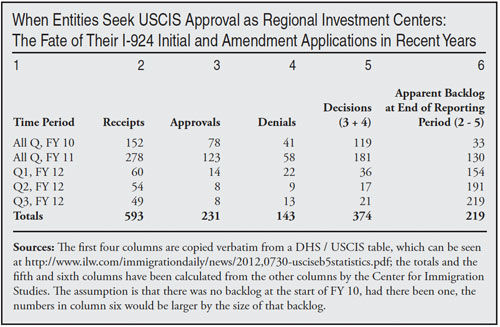As I have pointed out earlier, USCIS is not always skilled with numbers. When that trait is mixed with the inherent difficulty of an immigration agency managing an economic development/investment program some peculiar things happen.
All this relates to the cumbersome EB-5 (immigrant investor) program in which an alien family gets a full set of green cards in return for a private-sector investment of half a million dollars, a program described more thoroughly in the CIS Backgrounder "The Immigrant Investor (EB-5) Visa: A Program that Is, and Deserves to Be, Failing".
Playing the middleman role between alien investors and local users of their capital are a set of U.S.-based entities called regional centers, which are typically run by for-profit organizations. These are licensed by USCIS, a clumsy process in which the staff adjudicators have been less enthusiastic about many of the applications (the I-924) than the agency's Washington leadership.
The table below shows what has happened when would-be regional centers filed for that status in the last couple of years. (If your eyes glaze over at too many numbers, you best bail out now.)

Bear in mind that only the first four columns of numbers were released by USCIS; the troublesome ones, those in the fifth and sixth columns and in the totals, have been calculated from the government's data and they show a puzzling pattern. If you add up the approvals and denials (374 decisions) they do not equal the applications filed (593), leading to the question: what happened to the missing 219 applications?
And, more fundamentally, why is USCIS releasing a set of unexplained numbers that would raise such a question? Doesn't it read its own statistics?
Are the 219 cases simply being set aside and not acted upon? Has this backlog, as the table suggests, been built up steadily in recent years while the Obama administration has been running things? I doubt that.
The government says that its statistics — which do not add up — consist of received applications, approved ones, and denied ones. Perhaps there is a missing fourth category, such as withdrawals, that fills the statistical gap or maybe the missing 219 includes a mix of postponed decisions and withdrawals.
Presumably this general release of numbers was designed to show that the EB-5 program is moving along nicely and that there have been more approvals than denials. But if you examine these numbers it quickly becomes clear that only a minority of the regional center applications filed (593) have been approved (231) — and this is in an agency that routinely approves 90-95 percent of the applications it sees.
Is the problem that USCIS is handling this very modest pile of applications ever more slowly — or that it is not quite up to the task of using numbers to show what is actually happening? (None of the numbers involve anything beyond grade-school math.)
Neither answer is very encouraging when you bear in mind that USCIS is about to tackle a de facto amnesty for something like a million people.
